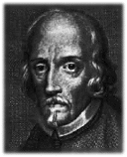|
 Born in Madrid, Spain, on January
17, 1600, Pedro Calderón de la Barca would eventually
become one of Spain's most important dramatists. Along with the
older playwright Lope De Vega, Calderón
would dominate Spain's Golden Age of theatre. Born in Madrid, Spain, on January
17, 1600, Pedro Calderón de la Barca would eventually
become one of Spain's most important dramatists. Along with the
older playwright Lope De Vega, Calderón
would dominate Spain's Golden Age of theatre.
Educated at the Jesuit Colegio Imperial, Calderón studied
law at the University of Alcalá (1614-15) and the University
of Salamanca (1615-21), but did not earn a degree. In 1621, he
entered the household of the Constable of Castille, Don Bernardino
Fernández de Velasco. Two years later, in 1623, he began
writing plays for the court.
Calderón's most famous play, Life Is a Dream,
explores the conflict between free will and predestination. It
tells the story of the King of Poland who imprisons his son in
a tower from birth in order to protect his reign and thwart the
predictions of astrologers who saw the boy taking his father's
throne. After several years, the King has a change of heart and
orders his son drugged and brought to his palace for a trial.
The young man behaves so badly, however, that the King soon banishes
him back to his prison. Waking up in the tower, the son is soon
convinced that he never left his lonely prison, that the entire
trial was just a dream. But a peasant uprising soon liberates
the confused prisoner once more and results in the boy being
crowned King. Fearful of waking once more in the tower and learning
that this new life is but a dream, this time he conducts himself
with discretion.
Aside from Life is a Dream, Calderón is perhaps
best known for his plays of honor and revenge. In The Mayor
of Zalamea, the captain of a visiting troop of soldiers,
certain of his impunity, abducts the daughter of a wealthy farmer,
rapes her, and ties her father to a tree. In this play, the father's
revenge might seem understandable to our modern sensibilities,
but Calderón also deals with honor and revenge in a trio
of wife-murder plays in which it may be more difficult to identify
with the agent of vengeance. In each of these plays, the wife
is murdered either directly or indirectly by the husband who
suspects her of infidelity and wishes to restore his lost honor.
Although it has been the subject of much debate, there is no
way to know whether Calderón approved of such measures
or whether he simply used this common social code to create dramatic
conflict. What is certain is that these revenge plays--which
make up a very small portion of Calderón's canon--have
become closely identified with the dramatist. These plays include
The Physician of his Honour, Secret Insult, Secret Vengeance,
and The Painter of his Own Dishonour.
Calderón became a priest in 1651, but continued to
write plays as the court dramatist for Philip IV. He also wrote
two autos sacramentales each year for the city of Madrid.
In his later years, he developed a series of elaborate mythological
themes that reflected the tastes and interests of the Spanish
Court during the waning years of the Golden Age. He died in Madrid
on May 25, 1681. Of his 120 surviving works, approximately 80
are autos sacramentales, morality plays celebrating the
mystery of the eucharist on Corpus Christi day.
|